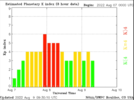Time Is Running Out for the Leap Second
Humanity struggles to impose order on the small end of the time scale, too. Lately the second is running into trouble. Traditionally the unit was defined in astronomical terms, as one-86,400th of the mean solar day (the time it takes Earth to rotate once on its axis). In 1967 the world’s metrologists instead began measuring time from the ground up, with atomic clocks. The official length of the basic unit, the second, was fixed at 9,192,631,770 vibrations of an atom of cesium 133. Eighty-six thousand four hundred such seconds compose one day.
But Earth’s rotation slows ever so slightly from year to year and the astronomical second (like the astronomical day) has gradually grown longer than the atomic one. To compensate, starting in 1972, metrologists began occasionally inserting an extra second — a leap second — to the end of an atomic day. In effect, whenever atomic time is a full second ahead, it stops for a second to allow Earth to catch up. Ten leap seconds were added to the atomic time scale in 1972, and 27 more have been added since.
Adding that extra second is no small task. Moreover, Earth’s rotation is slightly erratic, so the leap second is both irregular and unpredictable. Fifty years ago, those qualities made inserting the leap second difficult. Today the endeavor is a technical nightmare, because precise timing has become integral to society’s highly computerized infrastructure.
“What was before just a way of measuring the flow of time is today essential for transportation, location, defense, finance, space competition,” said Felicitas Arias, former director of the time department of the International Bureau of Weights and Measures, known as B.I.P.M. from its French name and based outside Paris. “Time is ruling the world.”
The process of squaring these two time scales has become so unruly that
the world’s time mavens are making a bold proposal: to abandon the leap second by 2035. Civilization would wholly embrace atomic time; and the difference, or tolerance, between atomic time and Earth time would go unspecified until timekeepers come up with a better plan for reconciling the two. A vote, in the form of Resolution D, is expected on Nov. 18 at a meeting in Versailles of the Bureau’s member nations.
“From a technical point of view,” said Patrizia Tavella, the current director of B.I.P.M.’s time department, “all the colleagues all over the world agree that we have to do something.”
(snip)
But the second is a huge amount of time in the technology of the internet. Cellphone transmissions, power grids and computer networks are synchronized to minuscule fractions of a second.
High-frequency traders in financial markets execute orders in thousandths and even billionths of a second. By international law, data packages related to these financial transactions must be time-stamped to that fine level of precision, recorded and made traceable back to Coordinated Universal Time, the universally agreed-upon standard managed by the timekeepers at the B.I.P.M.
(snip)
Russia, for instance, has tried to delay a shift away from the leap second because doing so would require extensive alterations to its GLONASS satellite system, which incorporates the extra second. As a result, the resolution has been phrased to postpone any change until 2035. The United Kingdom, historically and emotionally tethered to the astronomical standard, enshrined in Greenwich Mean Time, has been reluctant to commit publicly.
Coordinated Universal Time, or U.T.C., is tenderly constructed from readings made by atomic clocks kept at national laboratories around the world. These clocks tick off, or “realize,” their best seconds and send the measurements to the B.I.P.M. There, timekeepers painstakingly assemble the readings — averaging, weighting, adjusting for discrepancies — into an ideal second for everyone everywhere to agree on and employ, occasionally adding leap seconds as needed. This assembly process takes time. And so once a month the Bureau publishes the perfect time in the form of a newsletter, called Circular T, that tells each national clock how much it diverges from the international standard, to help it improve its aim the following month.
(snip)
The kludge is so technically difficult for digital technology to incorporate that other, ersatz methods of timekeeping — unofficial, but free of leap seconds and easier to implement — have begun to displace U.T.C., according to
a recent article in the journal Metrologia. To supporters of Resolution D,
removing the leap second from U.T.C. would make the standard time scale friendlier to modern digital technology, at least in the century following 2035. Coordinated Universal Time would still be universal, just not coordinated with Earth time.
The time scale most commonly used in place of U.T.C. is the American government’s global-positioning satellite system, or GPS. Each satellite in the GPS network, which is operated and maintained by the U.S. Space Force, carries atomic clocks that provide time data, along with information about longitude, latitude and altitude.
Users of GPS, which include cellphone and data networks, can determine the time of day to within 100 billionth of a second, and the information is free and widely available. But it is neither funneled through the B.I.P.M. nor adjusted for leap seconds. The United Nations’ International Telecommunication Union recently suggested that telecommunication networks make GPS, rather than U.T.C., their official time because it does not incorporate leap seconds and therefore is an uninterrupted flow of time.
To metrologists the implications are grave: Although GPS keeps good time, using it rather than U.T.C. would mean that time would no longer be overseen by an organization that must abide by international agreements.
“The increasing use of signals from the GPS satellites effectively means that the U.S. military controls a primary source of international time signals with almost no oversight nationally or internationally,” noted the Metrologia article, which was written by Dr. Levine, Dr. Tavella and Martin Milton, the director of the B.I.P.M.
Moreover, the clocks aboard satellites are inconsistent across systems. Russia’s GLONASS runs on U.T.C. (adjusted by three hours) and leap seconds, but the other satellite navigational systems do not, and they diverge from universal time by different amounts, depending on when they became operational. GPS and Galileo, the European system, are 18 seconds ahead of U.T.C. The Chinese system BeiDou is four seconds ahead. They each function well because they are internally consistent and because their divergence from U.T.C. can be tracked, but they are not traceable back to U.T.C.
Even computing systems that continue to insert the leap second do so in different ways. As a result, the time stamps required for commercial and financial transactions are sometimes out of whack during the adjustment period, risking system crashes and an occasional lack of traceability. Google smears the extra second across a whole day, while Meta, Alibaba and Microsoft each add the extra second in their own bespoke way. And according to the Metrologia paper, the number of errors in implementing the leap second is increasing over time.
“It is anarchy,” Dr. Tavella said.
An additional wrinkle looms. The leap second has been necessary because atomic time runs faster than Earth time. But that is changing: Earth’s rotation rate began speeding up right around the time the leap second was invented. This month or next, Earth time will catch up to atomic time. By about 2030, if the trend persists, Earth time will overtake atomic time by about a second — so metrologists will have to insert a negative leap second to keep the two time scales in sync.
In effect, a second will vanish. Such an experiment has never been tested on computer systems, and many metrologists fear a digital disaster. “The first time in the history of U.T.C. that a negative leap second occurs, and nobody knows what to do,”
(snip)
The Vatican, for instance, has argued for keeping the leap second, on existential grounds. Time “is a constant reminder of our mortality,” wrote the Rev. Pavel Gabor, an astrophysicist and the vice director of the Vatican Observatory Research Group in Tucson, Ariz., in “The Science of Time,” published in 2017.

 truthpress.com
truthpress.com













